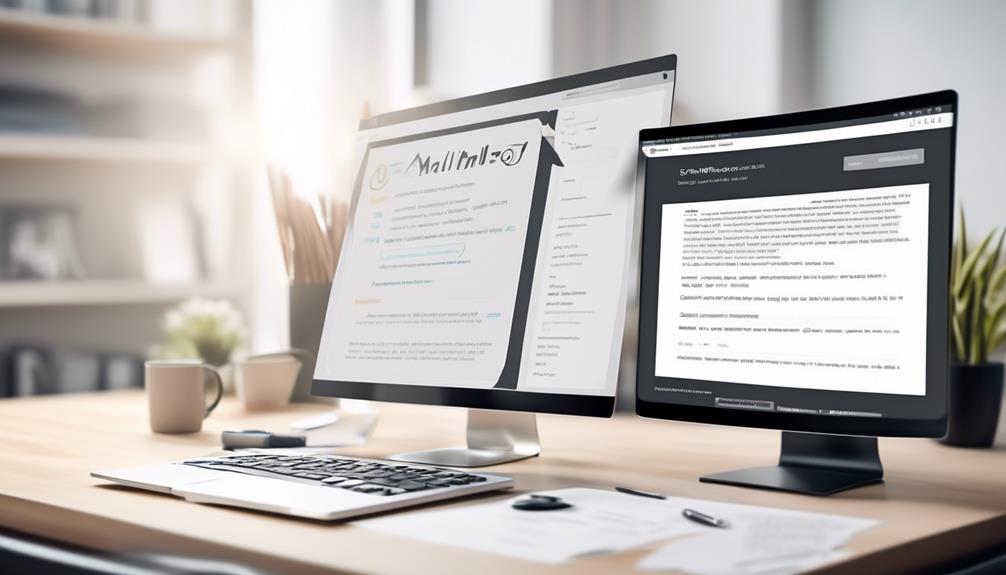Sending an email to our elected representatives is akin to establishing a line of communication for dialogue and collaboration. The difficulty in drafting an email to a member of Congress lies in the necessity to find the right equilibrium between formality and authenticity to guarantee that your message is conveyed effectively.
As we navigate the digital avenue of advocacy, it's crucial to strike a balance that captures attention and prompts action. Let's explore the art of composing impactful emails that resonate with legislators, fostering a channel for our voices to be heard and considered in the realm of policymaking.
Key Takeaways
- Include specific details to help the representative understand your position effectively.
- Familiarize yourself with your representative's priorities and positions for targeted communication.
- Craft a clear and concise message with a professional tone and language.
- Personalize your correspondence to evoke empathy and strengthen your argument.
Importance of Email Communication
Email communication with representatives is a powerful tool for influencing policy decisions and advocating for important issues. When reaching out to an elected official via email, it's crucial to include specific details such as the bill number or the exact nature of the issue you're addressing. Providing clear and concise information allows the elected official to understand your position effectively.
Additionally, including contact information in your email enables the representative or their staff to follow up with any questions or updates. Lawmakers value input from their constituents, and by utilizing email as a form of communication, you're actively participating in the democratic process.
Messaging lawmakers through email can lead to positive change in the community by ensuring that your voice is heard on issues that matter to you personally or have a local impact. Building a relationship with lawmakers through email communication is essential for effective advocacy and can make a significant difference in shaping policy decisions.
Understanding Your Representative

Researching your representative's background and voting record is crucial for understanding their priorities and positions. By delving into these key aspects, you can gain valuable insights into how they may approach certain issues that matter to you. Here are three essential steps to help you better comprehend your elected official:
- Familiarize Yourself with Committees and Caucuses:
Understanding the specific committees and caucuses your representative participates in can shed light on their areas of expertise and interest. This knowledge can provide valuable context when crafting your communication.
- Stay Updated Through Social Media:
Following your representative's social media accounts and website is a convenient way to keep abreast of their activities and public statements. This real-time information can help you tailor your letter or email to align with current events.
- Engage in Face-to-Face Conversations:
Attending town hall meetings and community events where your representative is present offers a unique opportunity for direct interaction. Building a personal connection can enhance your ability to effectively support your position on a particular bill number or issue.
Crafting a Clear Message
After familiarizing ourselves with our representative's background and staying updated on their activities, it's essential to craft a clear message when communicating our concerns or support for specific issues.
When reaching out to our representative via email, it's crucial to clearly state the purpose of our message in the subject line. Using a professional tone and language throughout the email will help convey our message effectively.
Keeping the email concise and to the point will ensure that our representative can quickly grasp the main points. Utilizing bullet points or numbered lists can help highlight key information, making it easier for the reader to follow.
Before hitting send, it's important to proofread and edit the email to ensure clarity and correct any grammar mistakes. Including relevant details such as bill numbers or specific examples can further strengthen our message and provide context for our concerns or support.
Tips for Effective Advocacy

Utilizing strategic communication methods is essential for maximizing the impact of our advocacy efforts when engaging with our representative. When sending the email, focusing on one issue allows for a clear and compelling message. In the subject line, mentioning the bill number grabs immediate attention and shows the importance of the email content.
- Personal Stories: Including personal anecdotes or stories related to the issue can evoke empathy and make our message more relatable.
- Call to Action: Clearly stating what action we want the representative to take, whether it's supporting a bill or attending an event, motivates them to act promptly.
- Gratitude: Expressing gratitude for any past support or actions taken by the representative creates a positive tone and fosters a stronger relationship.
Can the same email writing techniques be used for both a polite refund request and writing to a representative?
When reaching out to a representative, it’s important to use the same email writing techniques as you would for a polite refund request email. Being clear, concise, and respectful in your communication can help ensure a positive outcome for your inquiry or request.
Making Your Voice Heard
To effectively make our voices heard, we must engage with our legislators through impactful communication methods that convey our perspectives and concerns.
Elected officials greatly value input from their constituents when considering various bills and policies. Writing letters or emails is an important part of this process as it visually demonstrates the level of support or opposition to specific issues.
Moreover, a well-crafted message can have a significant impact on the decisions made by legislators. Personalizing your correspondence by sharing how certain issues directly affect you or your profession can further strengthen your argument and make it more relatable to the elected official.
Following up with legislators after your initial communication and maintaining an ongoing dialogue is also crucial. This not only helps build a relationship with your representative but also increases your influence on their future decisions.
Frequently Asked Questions
How Do You Address an Email to a Representative?
When addressing an email to a representative, we start by using proper salutations like 'Dear Representative' or 'Dear Senator.' Including our name, location, and reason for contacting in the introduction is key.
We clearly state the action we want the representative to take and explain its importance. Providing specific details, like bill numbers or policy issues, can make our email more impactful.
We always request a reply and share our contact information in the conclusion.
How Do You Write a Letter to a Representative?
When writing a letter to a representative, we must ensure it's clear, concise, and compelling. By focusing on one issue and providing relevant facts and statistics, we can strengthen our argument.
It's crucial to be specific about our concerns and include our name and location for authenticity.
Following up with a thank-you note after can help build a positive relationship with lawmakers.
How Do You Email a Bill Representative?
When we email a bill representative, it's vital to clearly express our stance on the issue.
In the subject line, we should state our position concisely.
The content should be brief, mentioning relevant bill numbers or policy details. Personalizing the email with any prior interactions can also make a difference.
Keeping the message professional and persuasive is essential to effectively communicate our perspective.
How Do You Write an Email to a Public Official?
When addressing a public official via email, we stress the importance of clarity and brevity.
Craft a compelling subject line to grab their attention. Begin with a polite greeting, state your purpose concisely, and provide relevant information or evidence to support your stance.
End with a clear call to action or request for a response.
Conclusion
Let's join hands in raising our voices and advocating for change. Together, we can make a difference in our community and shape the future we want to see.
As the saying goes, 'United we stand, divided we fall.' Let's stand united in our efforts to create positive change and ensure our voices are heard.
Thank you for your support and dedication to making a difference.









